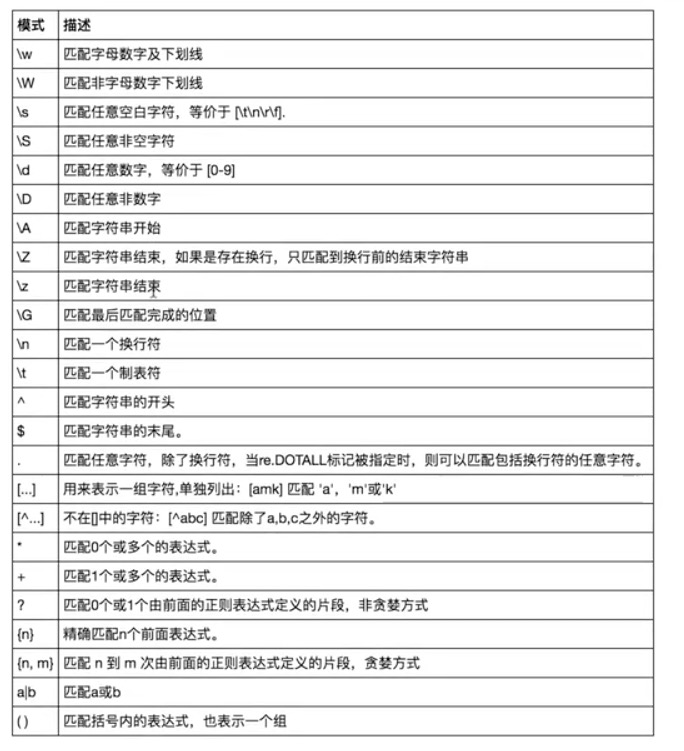day24-常用模块三
一、logging模块
一 日志级别
CRITICAL = 50 #FATAL = CRITICAL ERROR = 40 WARNING = 30 #WARN = WARNING INFO = 20 DEBUG = 10 NOTSET = 0 #不设置
二 默认级别为warning,默认打印到终端
import logging logging.debug('调试debug') logging.info('消息info') logging.warning('警告warn') logging.error('错误error') logging.critical('严重critical') ''' WARNING:root:警告warn ERROR:root:错误error CRITICAL:root:严重critical
三、全局配置详解
可在logging.basicConfig()函数中可通过具体参数来更改logging模块默认行为,可用参数有 filename:用指定的文件名创建FiledHandler(后边会具体讲解handler的概念),这样日志会被存储在指定的文件中。 filemode:文件打开方式,在指定了filename时使用这个参数,默认值为“a”还可指定为“w”。 format:指定handler使用的日志显示格式。 datefmt:指定日期时间格式。 level:设置rootlogger(后边会讲解具体概念)的日志级别 stream:用指定的stream创建StreamHandler。可以指定输出到sys.stderr,sys.stdout或者文件,默认为sys.stderr。若同时列出了filename和stream两个参数,则stream参数会被忽略。 format参数中可能用到的格式化串: %(name)s Logger的名字 %(levelno)s 数字形式的日志级别 %(levelname)s 文本形式的日志级别 %(pathname)s 调用日志输出函数的模块的完整路径名,可能没有 %(filename)s 调用日志输出函数的模块的文件名 %(module)s 调用日志输出函数的模块名 %(funcName)s 调用日志输出函数的函数名 %(lineno)d 调用日志输出函数的语句所在的代码行 %(created)f 当前时间,用UNIX标准的表示时间的浮 点数表示 %(relativeCreated)d 输出日志信息时的,自Logger创建以 来的毫秒数 %(asctime)s 字符串形式的当前时间。默认格式是 “2003-07-08 16:49:45,896”。逗号后面的是毫秒 %(thread)d 线程ID。可能没有 %(threadName)s 线程名。可能没有 %(process)d 进程ID。可能没有 %(message)s用户输出的消息 #========使用 import logging logging.basicConfig(filename='access.log', format='%(asctime)s - %(name)s - %(levelname)s -%(module)s: %(message)s', datefmt='%Y-%m-%d %H:%M:%S %p', level=10) logging.debug('调试debug') logging.info('消息info') logging.warning('警告warn') logging.error('错误error') logging.critical('严重critical') #========结果 access.log内容: 2017-07-28 20:32:17 PM - root - DEBUG -test: 调试debug 2017-07-28 20:32:17 PM - root - INFO -test: 消息info 2017-07-28 20:32:17 PM - root - WARNING -test: 警告warn 2017-07-28 20:32:17 PM - root - ERROR -test: 错误error 2017-07-28 20:32:17 PM - root - CRITICAL -test: 严重critical part2: 可以为logging模块指定模块级的配置,即所有logger的配置
#logger:产生日志的对象 #Filter:过滤日志的对象 #Handler:接收日志然后控制打印到不同的地方,FileHandler用来打印到文件中,StreamHandler用来打印到终端 #Formatter对象:可以定制不同的日志格式对象,然后绑定给不同的Handler对象使用,以此来控制不同的Handler的日志格式
五、应用
import os import logging.config # 定义三种日志输出格式 开始 standard_format = '[%(asctime)s][%(threadName)s:%(thread)d][task_id:%(name)s][%(filename)s:%(lineno)d]' \ '[%(levelname)s][%(message)s]' #其中name为getlogger指定的名字 simple_format = '[%(levelname)s][%(asctime)s][%(filename)s:%(lineno)d]%(message)s' id_simple_format = '[%(levelname)s][%(asctime)s] %(message)s' # 定义日志输出格式 结束 logfile_dir = os.path.dirname(os.path.abspath(__file__)) # log文件的目录 logfile_name = 'all2.log' # log文件名 # 如果不存在定义的日志目录就创建一个 if not os.path.isdir(logfile_dir): os.mkdir(logfile_dir) # log文件的全路径 logfile_path = os.path.join(logfile_dir, logfile_name) # log配置字典 LOGGING_DIC = { 'version': 1, 'disable_existing_loggers': False, 'formatters': { 'standard': { 'format': standard_format }, 'simple': { 'format': simple_format }, }, 'filters': {}, 'handlers': { #打印到终端的日志 'console': { 'level': 'DEBUG', 'class': 'logging.StreamHandler', # 打印到屏幕 'formatter': 'simple' }, #打印到文件的日志,收集info及以上的日志 'default': { 'level': 'DEBUG', 'class': 'logging.handlers.RotatingFileHandler', # 保存到文件 'formatter': 'standard', 'filename': logfile_path, # 日志文件 'maxBytes': 1024*1024*5, # 日志大小 5M 'backupCount': 5, 'encoding': 'utf-8', # 日志文件的编码,再也不用担心中文log乱码了 }, }, 'loggers': { #logging.getLogger(__name__)拿到的logger配置 '': { 'handlers': ['default', 'console'], # 这里把上面定义的两个handler都加上,即log数据既写入文件又打印到屏幕 'level': 'DEBUG', 'propagate': True, # 向上(更高level的logger)传递 }, }, } def load_my_logging_cfg(): logging.config.dictConfig(LOGGING_DIC) # 导入上面定义的logging配置 logger = logging.getLogger(__name__) # 生成一个log实例 logger.info('It works!') # 记录该文件的运行状态 if __name__ == '__main__': load_my_logging_cfg()
具体使用见链接与官网
https://www.cnblogs.com/linhaifeng/articles/6384466.html#_label12
二、re模块
一:什么是正则?
正则就是用一些具有特殊含义的符号组合到一起(称为正则表达式)来描述字符或者字符串的方法。或者说:正则就是用来描述一类事物的规则。(在Python中)它内嵌在Python中,并通过 re 模块实现。正则表达式模式被编译成一系列的字节码,然后由用 C 编写的匹配引擎执行。

# =================================匹配模式================================= #一对一的匹配 # 'hello'.replace(old,new) # 'hello'.find('pattern') #正则匹配 import re #\w与\W print(re.findall('\w','hello egon 123')) #['h', 'e', 'l', 'l', 'o', 'e', 'g', 'o', 'n', '1', '2', '3'] print(re.findall('\W','hello egon 123')) #[' ', ' '] #\s与\S print(re.findall('\s','hello egon 123')) #[' ', ' ', ' ', ' '] print(re.findall('\S','hello egon 123')) #['h', 'e', 'l', 'l', 'o', 'e', 'g', 'o', 'n', '1', '2', '3'] #\n \t都是空,都可以被\s匹配 print(re.findall('\s','hello \n egon \t 123')) #[' ', '\n', ' ', ' ', '\t', ' '] #\n与\t print(re.findall(r'\n','hello egon \n123')) #['\n'] print(re.findall(r'\t','hello egon\t123')) #['\n'] #\d与\D print(re.findall('\d','hello egon 123')) #['1', '2', '3'] print(re.findall('\D','hello egon 123')) #['h', 'e', 'l', 'l', 'o', ' ', 'e', 'g', 'o', 'n', ' '] #\A与\Z print(re.findall('\Ahe','hello egon 123')) #['he'],\A==>^ print(re.findall('123\Z','hello egon 123')) #['he'],\Z==>$ #^与$ print(re.findall('^h','hello egon 123')) #['h'] print(re.findall('3$','hello egon 123')) #['3'] # 重复匹配:| . | * | ? | .* | .*? | + | {n,m} | #. print(re.findall('a.b','a1b')) #['a1b'] print(re.findall('a.b','a1b a*b a b aaab')) #['a1b', 'a*b', 'a b', 'aab'] print(re.findall('a.b','a\nb')) #[] print(re.findall('a.b','a\nb',re.S)) #['a\nb'] print(re.findall('a.b','a\nb',re.DOTALL)) #['a\nb']同上一条意思一样 #* print(re.findall('ab*','bbbbbbb')) #[] print(re.findall('ab*','a')) #['a'] print(re.findall('ab*','abbbb')) #['abbbb'] #? print(re.findall('ab?','a')) #['a'] print(re.findall('ab?','abbb')) #['ab'] #匹配所有包含小数在内的数字 print(re.findall('\d+\.?\d*',"asdfasdf123as1.13dfa12adsf1asdf3")) #['123', '1.13', '12', '1', '3'] #.*默认为贪婪匹配 print(re.findall('a.*b','a1b22222222b')) #['a1b22222222b'] #.*?为非贪婪匹配:推荐使用 print(re.findall('a.*?b','a1b22222222b')) #['a1b'] #+ print(re.findall('ab+','a')) #[] print(re.findall('ab+','abbb')) #['abbb'] #{n,m} print(re.findall('ab{2}','abbb')) #['abb'] print(re.findall('ab{2,4}','abbb')) #['abb'] print(re.findall('ab{1,}','abbb')) #'ab{1,}' ===> 'ab+' print(re.findall('ab{0,}','abbb')) #'ab{0,}' ===> 'ab*' #[] print(re.findall('a[1*-]b','a1b a*b a-b')) #[]内的都为普通字符了,且如果-没有被转意的话,应该放到[]的开头或结尾 print(re.findall('a[^1*-]b','a1b a*b a-b a=b')) #[]内的^代表的意思是取反,所以结果为['a=b'] print(re.findall('a[0-9]b','a1b a*b a-b a=b')) #[]内的^代表的意思是取反,所以结果为['a=b'] print(re.findall('a[a-z]b','a1b a*b a-b a=b aeb')) #[]内的^代表的意思是取反,所以结果为['a=b'] print(re.findall('a[a-zA-Z]b','a1b a*b a-b a=b aeb aEb')) #[]内的^代表的意思是取反,所以结果为['a=b'] #\# print(re.findall('a\\c','a\c')) #对于正则来说a\\c确实可以匹配到a\c,但是在python解释器读取a\\c时,会发生转义,然后交给re去执行,所以抛出异常 print(re.findall(r'a\\c','a\c')) #r代表告诉解释器使用rawstring,即原生字符串,把我们正则内的所有符号都当普通字符处理,不要转义 print(re.findall('a\\\\c','a\c')) #同上面的意思一样,和上面的结果一样都是['a\\c'] #():分组 print(re.findall('ab+','ababab123')) #['ab', 'ab', 'ab'] print(re.findall('(ab)+123','ababab123')) #['ab'],匹配到末尾的ab123中的ab print(re.findall('(?:ab)+123','ababab123')) #findall的结果不是匹配的全部内容,而是组内的内容,?:可以让结果为匹配的全部内容 print(re.findall('href="(.*?)"','<a href="http://www.baidu.com">点击</a>'))#['http://www.baidu.com'] print(re.findall('href="(?:.*?)"','<a href="http://www.baidu.com">点击</a>'))#['href="http://www.baidu.com"'] #| print(re.findall('compan(?:y|ies)','Too many companies have gone bankrupt, and the next one is my company'))
import re s=''' http://www.baidu.com egon@oldboyedu.com 你好 010-3141 ''' #最常规匹配 # content='Hello 123 456 World_This is a Regex Demo' # res=re.match('Hello\s\d\d\d\s\d{3}\s\w{10}.*Demo',content) # print(res) # print(res.group()) # print(res.span()) #泛匹配 # content='Hello 123 456 World_This is a Regex Demo' # res=re.match('^Hello.*Demo',content) # print(res.group()) #匹配目标,获得指定数据 # content='Hello 123 456 World_This is a Regex Demo' # res=re.match('^Hello\s(\d+)\s(\d+)\s.*Demo',content) # print(res.group()) #取所有匹配的内容 # print(res.group(1)) #取匹配的第一个括号内的内容 # print(res.group(2)) #去陪陪的第二个括号内的内容 #贪婪匹配:.*代表匹配尽可能多的字符 # import re # content='Hello 123 456 World_This is a Regex Demo' # # res=re.match('^He.*(\d+).*Demo$',content) # print(res.group(1)) #只打印6,因为.*会尽可能多的匹配,然后后面跟至少一个数字 #非贪婪匹配:?匹配尽可能少的字符 # import re # content='Hello 123 456 World_This is a Regex Demo' # # res=re.match('^He.*?(\d+).*Demo$',content) # print(res.group(1)) #只打印6,因为.*会尽可能多的匹配,然后后面跟至少一个数字 #匹配模式:.不能匹配换行符 content='''Hello 123456 World_This is a Regex Demo ''' # res=re.match('He.*?(\d+).*?Demo$',content) # print(res) #输出None # res=re.match('He.*?(\d+).*?Demo$',content,re.S) #re.S让.可以匹配换行符 # print(res) # print(res.group(1)) #转义:\ # content='price is $5.00' # res=re.match('price is $5.00',content) # print(res) # # res=re.match('price is \$5\.00',content) # print(res) #总结:尽量精简,详细的如下 # 尽量使用泛匹配模式.* # 尽量使用非贪婪模式:.*? # 使用括号得到匹配目标:用group(n)去取得结果 # 有换行符就用re.S:修改模式



